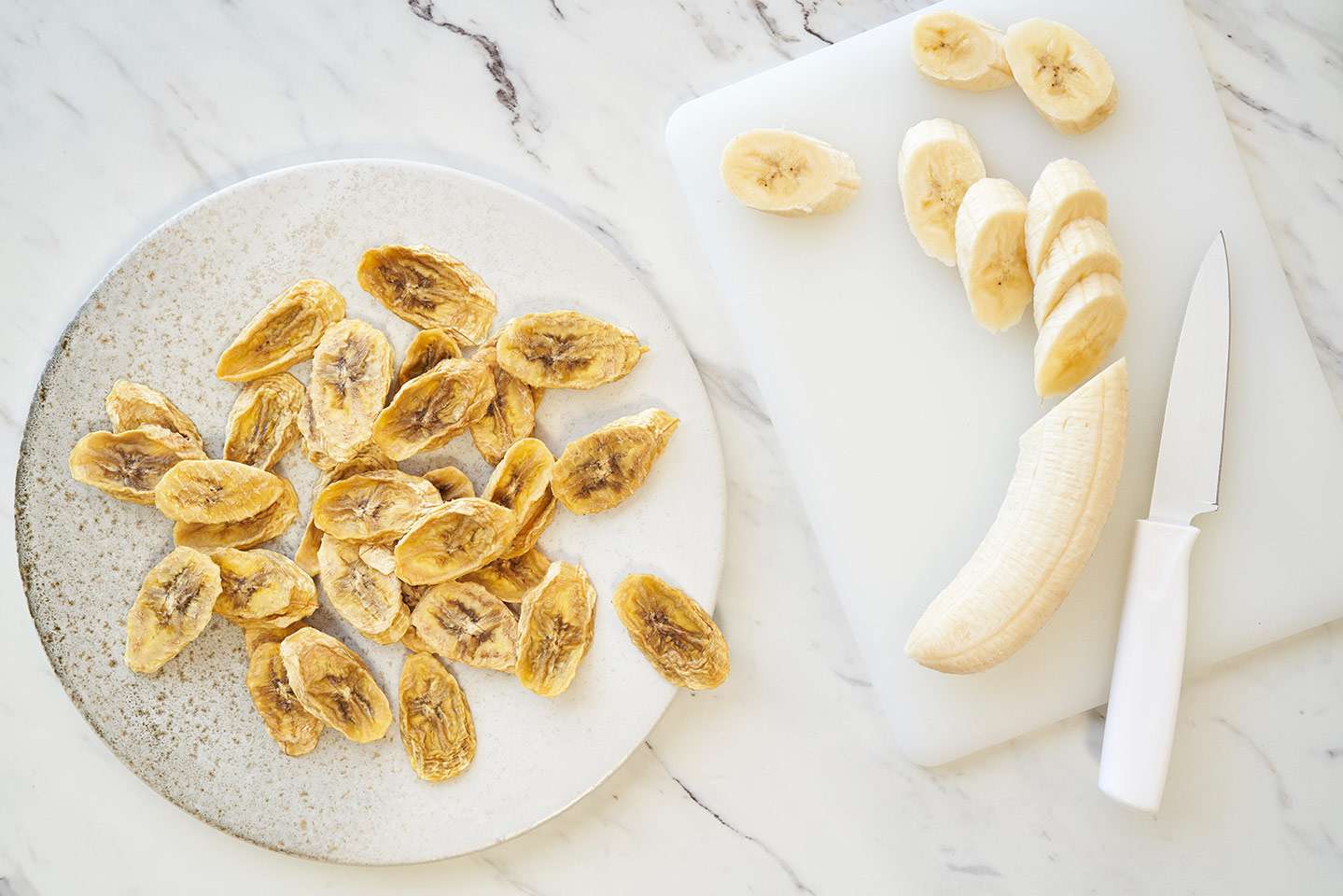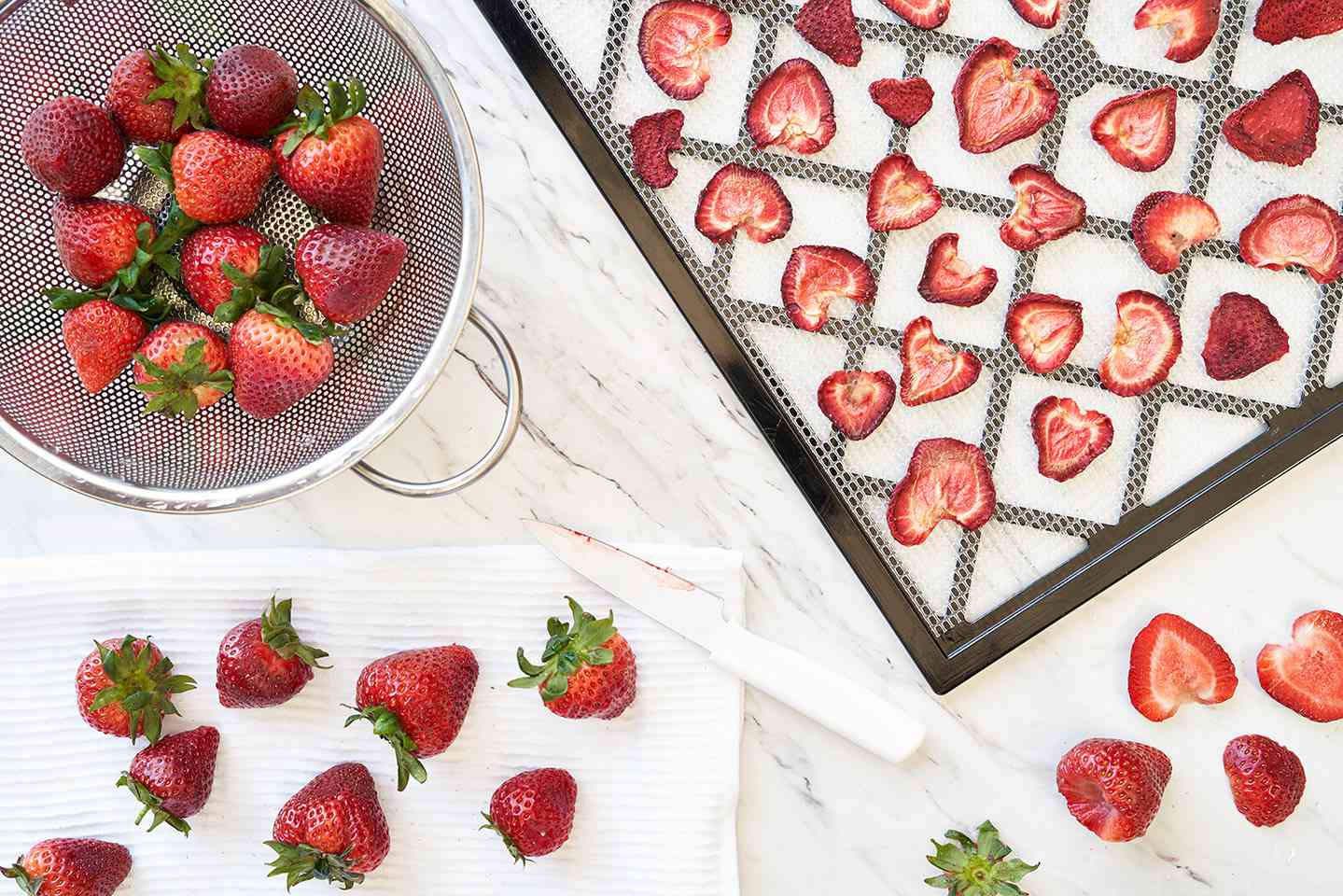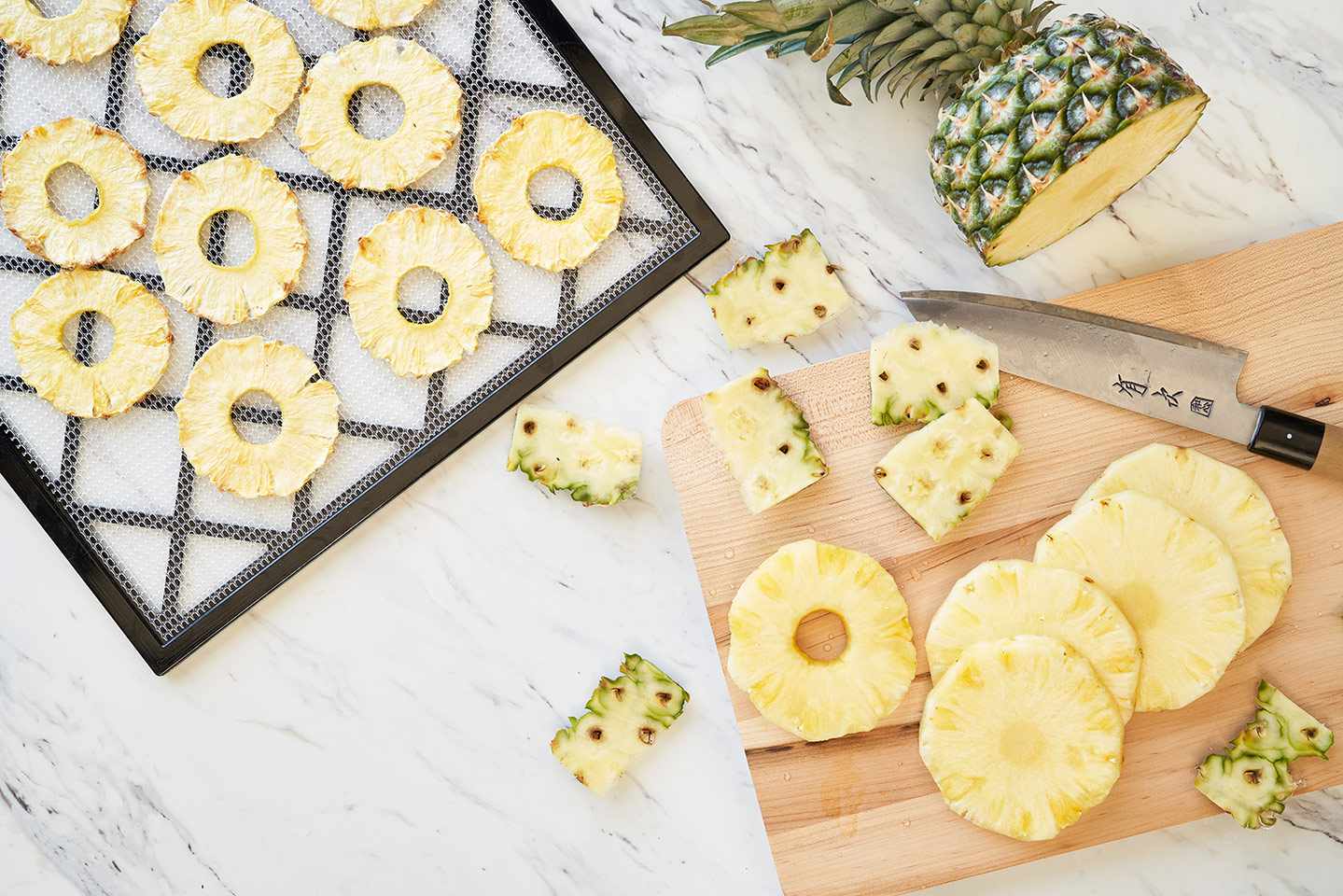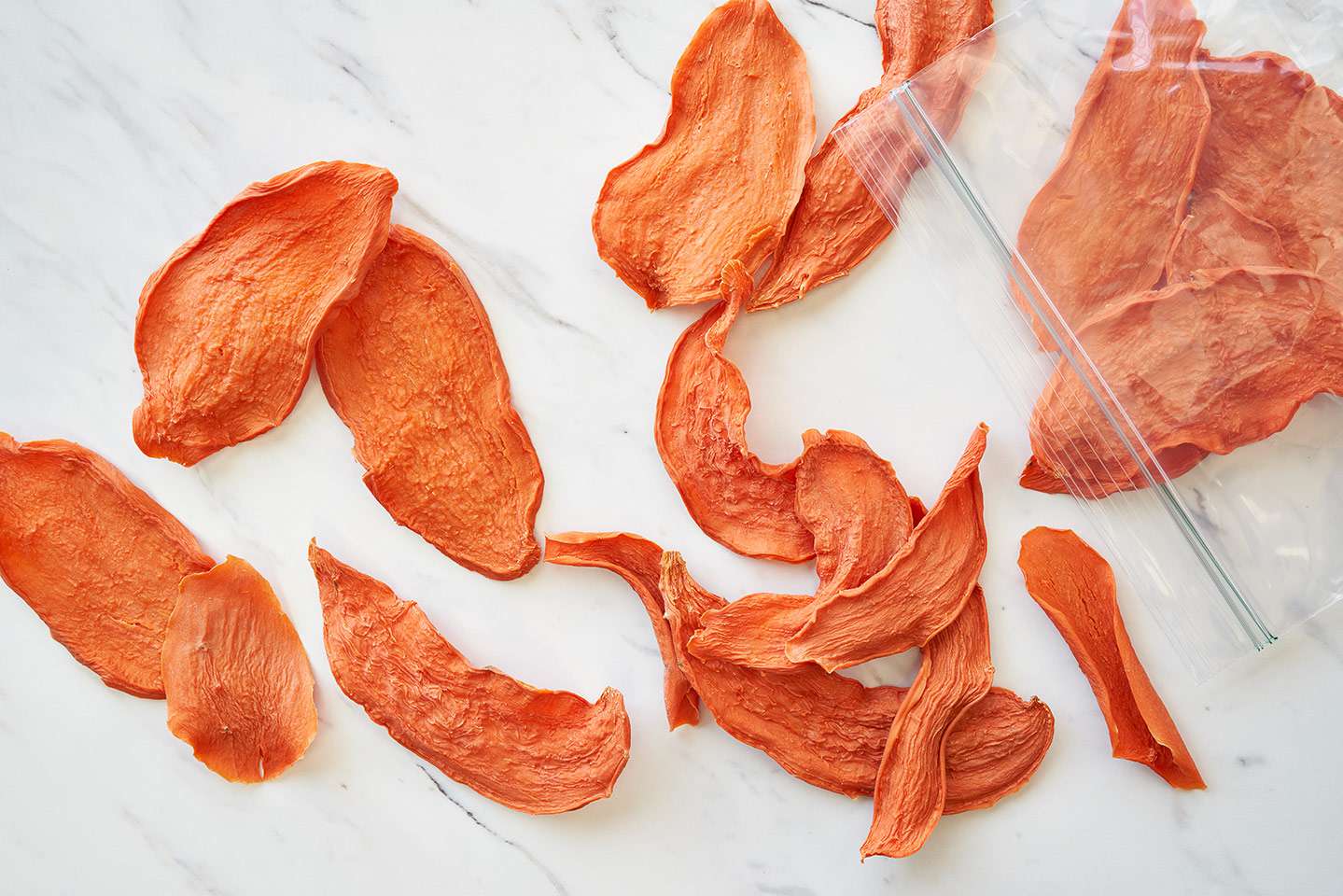Dehydrated vegetables and fruit aren't just for backpacking hikers and making oatmeal-raisin cookies. Take a spin through the healthy snacks section of any grocery store, and, clearly, veggie chips and fruit leathers are on shelves and here to stay. And they're not just for snacking! Serve zucchini chips with grilled sausage for a crunchy veggie side dish even picky eaters will love. Use dried peppers to turn up the heat on your winter soup. Snip up dried tomatoes into bite-size pieces to top off your homemade pizza.
Learning how to dehydrate fruits and vegetables couldn't be simpler (we're talking single ingredients). So if you're obsessed with store-bought sweet potato chips or addicted to apple strips, it might be time to invest in a dehydrator. It's an affordable, easy and delicious way to preserve seasonal produce for long-term storage and stash snacks for a rainy day. And it's especially helpful if you have a CSA box or backyard garden that's bumping right now.
How to Prep Fruits & Vegetables for Drying
Step 1: Pick peak-season produce.
Some people think dehydrating is a way to use up anything that's bruised, battered or has seen better days. But in fact, drying concentrates flavor, so start with prime produce you're excited to bite into.
Step 2: Rinse, scrub and peel.
Buy organic, if your budget allows, and give fruits and veggies a quick rinse or scrub. Whether to peel or not is up to you, but keep in mind, skins will only get tougher in texture.
Step 3: Thinly slice with a sharp knife or mandoline.
Go for consistently sized pieces, about ⅛ to ¼ inch thick, which will dry at the same rate. Slices will shrink as they dry, so go a touch thicker than you want for the end result.
Step 4: Dip fruit in citrus water.
This step is optional, and only for fruit that can brown, like bananas and apples. Fill a bowl with equal parts lemon juice and water, and soak the slices in it for 10 minutes. Remove the fruit from the water and pat dry on paper towels.
Step 5: Blanch veggies in boiling water.
Also optional, this step is only necessary for starchy vegetables, like sweet potatoes or sugar snap peas. Boil them for a few minutes, then shock in an ice bath to stop the cooking and preserve bright colors.

(Photos: James Ellerker)
How to Dry Fruits & Vegetables Using a Dehydrator
Using a dehydrator is push-button easy: just plug it in, turn the dial and vroom. The best models circulate hot air evenly throughout, so you don't have to worry about dehydrator trays. All of the following recipes were testing using an Excalibur 9-Tray 48-Hour Timer Digital Dehydrator. Excalibur generally recommends dehydrating fruit at 135°F, and vegetables at 125°F. Drying times vary widely, and they're usually provided as ranges, because it totally depends on the type of produce, how ripe and juicy it is, how thinly you sliced it, and what the humidity is like that day. Check the manufacturer's instructions, Google the weather, and give it your best estimate.
How to Dehydrate Fruits & Vegetables in the Oven
Drying in the oven is also an option, although ovens run slightly hotter, can be inconsistent, and you might see a spike on your electric bill. Preheat the oven to the lowest setting, usually 200°F. Line your baking sheets with nonstick mats or parchment paper. Place a cooling rack on top of the parchment paper; this will help the air circulate all around your fruits and vegetables. Drying times will be significantly shorter, and you might want to rotate the pans.
How to Store Dried Produce
Dehydrated foods are done when totally dry to the touch and anywhere from leathery and pliable to crisp and brittle. (The National Center for Home Food Preservation is a good reference for more in-depth guidance on packaging and storing dried foods.) Cool completely and transfer to airtight containers, such as plastic snap-tops, mason jars or freezer bags. Store in a cool, dark place. After a few days, shake one of the containers. If you notice any moisture, transfer the contents back to the dehydrator for another stint. Dried and stored properly, fruits and vegetables can last for several months.
10 Best Fruits & Vegetables to Dehydrate

1. Bananas
Make cute dried banana coins for a healthy snack kids love. Peel bananas, slice into ⅛ to ¼ inch thick disks and soak in citrus water for 10 minutes to avoid browning. Dehydrate according to the manufacturer's instructions, at 135°F for 6-10 hours, or in the oven at 200°F for 5-7 hours.

2. Apples
Dried apples are an old-school treat and dehydrating apples couldn't be easier. Peel and core apples, if you like, slice fruit into rounds ¼ to ⅜ inch thick, and soak in citrus water for 10 minutes, to avoid browning. Dehydrate according to the manufacturer's instructions, at 135°F for 7-15 hours, or in the oven at 200°F for 6-8 hours.

3. Strawberries
Sweet dried strawberries go great with granola. Hull strawberries, and slice ¼ to ⅜ inch thick, or cut in half if they're really little. Dehydrate according to the manufacturer's instructions, at 135°F for 7-15 hours, or in the oven at 200°F for 5-7 hours.

4. Mangoes
Mango strips taste like sunshine. Peel mango, cut the flesh away from the flat core, and slice ¼ inch thick. Dehydrate according to the manufacturer's instructions, at 135°F for 7-15 hours, or in the oven at 200°F for 6-8 hours.

5. Pineapple
Dried pineapple wins the pretty prize. Cut off the top and bottom, trim away the tough exterior, and slice ¼ to ½ inch thick, removing the core. Dehydrate according to the manufacturer's instructions, at 135°F for 10-18 hours, or in the oven at 200°F for 8-10 hours.

6. Tomatoes
Don't call it a comeback–dried tomatoes are still sexy for pasta night. Top tomatoes, remove the cores, if necessary, and slice ¼ inch thick, or cut cherry tomatoes in half. Dehydrate according to the manufacturer's instructions, at 155°F for 5-9 hours, or in the oven at 200°F for 4-6 hours.

7. Sweet Potatoes
They'll never be as crispy as deep-fried chips, but dried sweet potatoes are still crave-worthy. Peel sweet potatoes, slice ¼ inch thick, blanch in boiling water for several minutes, and shock in an ice bath. Dehydrate according to the manufacturer's instructions, at 125°F for 7-11 hours, or in the oven at 200°F for 6-8 hours.

8. Zucchini
Dehydrating can save a bumper crop of summer squash. Trim the tops and bottoms, and slice ⅛ or ¼ inch thick. Dehydrate according to the manufacturer's instructions, at 125°F for 7-11 hours, or in the oven at 200°F for 5-7 hours.

9. Bell Peppers
In a confetti of colors, dried peppers are fun for soup mixes. Remove the ribs and seeds, and slice ¼ inch thick or chop. Dehydrate according to the manufacturer's instructions, at 125°F for 4-8 hours, or in the oven at 200°F for 4-6 hours.

10. Sugar Snap Peas
Better for you than french fries, dried peas make a sweet snack. Trim and remove the strings, if necessary, blanch in boiling water for a couple of minutes, and shock in an ice bath. Dehydrate according to the manufacturer's instructions, at 125°F for 5-13 hours, or in the oven at 200°F for 4-6 hours.
This article was from EatingWell and was legally licensed through the Industry Dive publisher network. Please direct all licensing questions to legal@industrydive.com.








